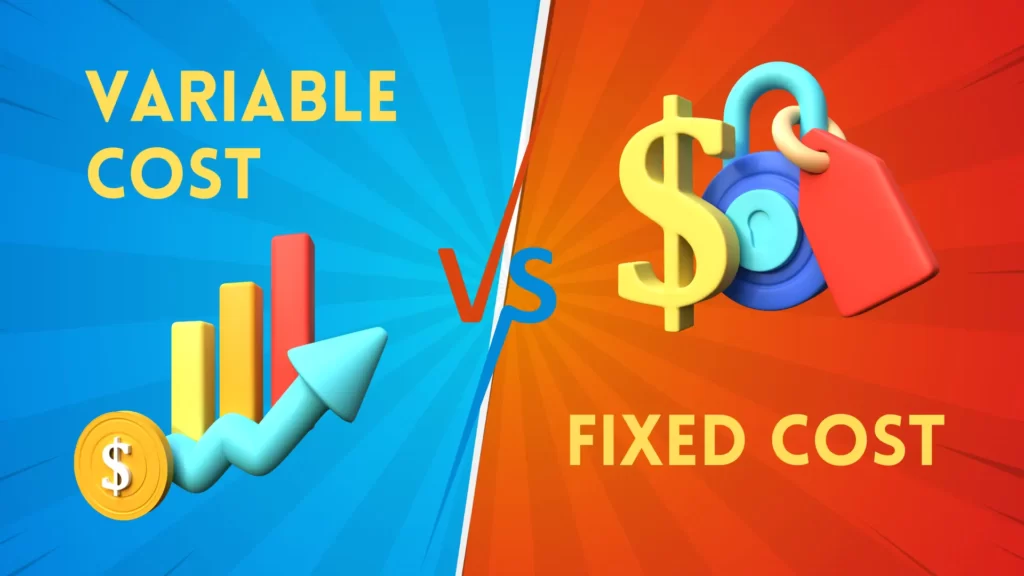Fixed Cost vs. Variable Cost …. What’s the difference? Variable cost varies with the level of output while fixed cost remains fixed at any level of production output. With regards to per unit cost: variable cost remains fixed at any level of production while fixed cost reduces as the level of output increases. By adding up both cost, you will get total cost.
Total Cost = Fixed Cost + Variable cost

What Is Variable Cost?
In This Article
ToggleVariable cost is the cost which changes with the change in the business activity or production output. It varies with the change in the total production quantity. If, the production output is zero, the variable cost will also be zero.
The examples of variable cost includes:
- Wages
- Sales commission
- Packaging cost
- Raw material cost
- Transportation cost
Graphical Presentation

What Is Fixed Cost?
Unlike variable costs, fixed cost remains same and unchanged with the increase in production output. The per unit cost may varies with the change in production quantity. Fixed costs do not affect by any temporary change in the business activity.
Its example includes:
- Salary of permanent staff
- Lease payments
- Depreciation
- Rent expense
Graphical Presentation

Fixed Cost vs. Variable Cost: Example
Now let’s compare these two types of cost together with the help of an example. Assume Smart Décor is a furniture manufacturing company and it cost $220 to produce one dining table. Moreover, they have to pay $10,000 as rent expense each month. The production level is 20, 30, 40, 50, 60, and 70 for the next coming consecutive years.
The table shows each months fixed, variable and total cost.
Unit Produced | Fixed Cost | Per Unit Variable Cost | Total Variable Cost | Total Cost |
20 | 10,000 | 220 | 4400 | 14,400 |
30 | 10,000 | 220 | 6600 | 16,600 |
40 | 10,000 | 220 | 8800 | 18,800 |
50 | 10,000 | 220 | 11000 | 21,000 |
60 | 10,000 | 220 | 13200 | 23,200 |
70 | 10,000 | 220 | 15400 | 25,400 |

Here, you can see that at 20 units, the fixed cost is $10,000 while the variable cost is $4,400. And at 60 units, the fixed cost is still same $10,000 and the variable cost is 13,200. So, at any production level, fixed cost is same and variable cost increases with the increase in production level.
Difference between Fixed Cost and Variable Cost
| Variable Cost | Fixed Cost |
Total Cost | Total variable cost changes or increases as the level of total production increases and vice versa. | Total fixed cost remains fixed throughout the production tenure. It does not increase or decrease as the total production increases. |
Per Unit Cost | Variable per unit cost remains fixed. For example: manufacturing of one glass may cost you $10. So, per unit cost will be $10 whether you manufacture 20 units or 030 units. | Fixed unit cost decreases as the level of output increases. For example, you have to pay $10,000 as the rent expenses every month. As during 1st month your production level will 20 units. So per unit cost will be 10000/20= 500 per unit. In 2nd month, the production level will be 30 units. So, the cost will be 10000/30= 333 per unit. Here, per unit cost reduces. |
Zero Production level | At zero production level, the variable cost will also be zero. As you know one glass will cost you $10. If you don’t manufacture any glass then here will be no cost. | Here, you know that every month you have to pay $10,000 as rent expense. So at zero production level, where you don’t manufacture any unit or glass, you have to pay that rent expense. |
Graphical Presentation | Its graph has an increasing upward curve. | Its shows no increasing or decreasing curve. Its curve is always a horizontal fixed line. |
Dependency | It depends on the volume of production. | It depends on time period. As it is fixed for a certain period of time. |
Impact on Profit | It has no impact on profit because as the production increases so as the variable cost. | Fixed cost divided over all the production. So, as the production level increases fixed cost reduces and increase profitability. |
Example | Wages, commission, raw material, advertisement expense. | Permanent salary, commission, utility bill, rent expense, loan payments. |

Classification Of Cost
Classification of cost based on categorizing the cost according to its characteristics, features, frequency, nature, and type is a logical process which facilitate economic analysis and fulfillment of accounting objectives. Cost in the business process could be defined as a sacrificed value in order to gain something in return. With the help of cost classification, expenses are separated into different group of expenses including mixed cost, variable or fixed costs, period or product costs, indirect or direct costs, incremental or opportunity costs, and the sunk costs.
Advantages of Classifying Cost into Fixed and Variable Cost
The advantages of classifying cost into fixed and variable cost have been discussed in detail below:
- Classification of could help to formulate an effective budget.
- With the help of classifying the cost into variable or fixed cost, organizations can deter-determine and fix the selling price in the special market or slum or depression sessions. The cost should include prime cots and variable cost.
- Cost classification is very essential in Cost-volume profit analysis.
- It helps to better control the expenses based on fixed and variable costs. The lower management could control the variable cost and the top management could control the fixed cost.
- Cost classification assist in managerial decision-making process.
